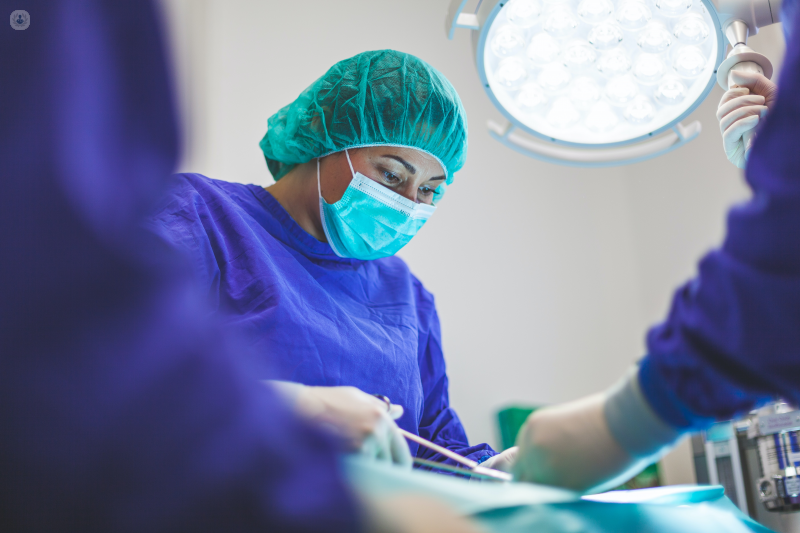When is arthroscopic shoulder surgery needed?
Escrito por:Arthroscopic (keyhole) shoulder surgery is a modern surgical technique used to diagnose and treat a wide variety of shoulder conditions. It uses a series of small incisions to allow a surgeon to look into the shoulder with a small camera (arthroscope) and assess cartilage, ligaments and tendons.
In this article, Mr Phil Wright, one of our top consultant orthopaedic surgeons explains what arthroscopic shoulder surgery is used for, how it’s performed and what you can expect during the recovery period.

What problems can arthroscopic shoulder surgery be used to treat?
Arthroscopic (keyhole) shoulder surgery can treat many problems including:
- Arthritis
- Inflammation
- Tears of the ligaments or tendons (the ‘ropes’ that connect bone to bone or muscle to bone)
In recent years, there have been many advances in the development of surgical instruments and devices which allow increasingly complex procedures to be performed.
When is arthroscopic shoulder surgery needed?
Shoulder problems are very common and most resolve over a few weeks or months without treatment, especially those that occur spontaneously rather than as a result of an injury. When symptoms fail to settle within a few weeks, pain-relieving tablets, modifying activities and gentle exercises are often helpful. The advice of an experienced physiotherapist is invaluable in deciding which exercises are most likely to help and ensuring they are being done correctly. Where pain makes it difficult to perform physiotherapy a pain-relieving injection can be useful to overcome this.
If symptoms persist, despite non-surgical treatment, surgery may be appropriate. Where there is a structural problem within the shoulder, arthroscopic surgery affords the opportunity to repair detached ligaments or tendons which may improve pain, strength or stability. In addition, stiff shoulders can often be improved by releasing scar tissue inside the shoulder. Procedures to remove inflamed tissue and bone are less commonly carried out as recent scientific evidence has suggested that physiotherapy may be just as effective.
A thorough discussion with your surgeon is essential in deciding if surgery for any shoulder condition is the right choice for you.
How is arthroscopic shoulder surgery performed?
Arthroscopic shoulder surgery is normally performed under a general anaesthetic. In many cases, a regional anaesthetic “block” is performed. This involves injecting local anaesthetic around the nerves at the top of the arm to provide pain relief after the procedure.
During the operation, the surgeon inserts a camera (arthroscope) and instruments through a series of small keyhole incisions around the shoulder. Fluid is pumped into the shoulder to allow a clear view of the cartilage, ligaments and tendons. Photographs and videos may also be taken. Through the same keyholes, instruments can smooth bone and remove inflamed tissue in addition to enabling the insertion of small screws threaded with sutures into the bone to repair detached ligaments and tendons.

At the end of surgery, the keyhole wounds may be stitched although many are so small they can be left to heal on their own. Dressings are applied including an absorbent pad to soak up any fluid from the shoulder. A sling is used at least until the regional block has worn off and in cases where a repair has been performed for up to four weeks. Most patients can go home on the same day as surgery.
Before discharge, a physiotherapist gives advice on how to look after the shoulder whilst using a sling and which exercises should be performed in the first few weeks after the procedure.
What are the risks of arthroscopic shoulder surgery?
All surgical procedures have the potential for complications. Fortunately, these are rare with arthroscopic shoulder surgery. There are risks of infection, major bleeding or damage to nerves, and whilst these are potentially very serious, they are very rare, occurring in less than 1% of patients.
Some swelling and minor stiffness is very common but mostly resolves over the first six weeks after the operation. Significant stiffness (frozen shoulder) can occur in up to 15% of patients but the majority of these patients will improve over time with exercise and support from a physiotherapist. In some cases, an injection to stretch the shoulder lining (hydrodistension) can bring about significant relief.
It’s important to bear in mind that although arthroscopic shoulder surgery leaves minimal externally visible scars it is often still a major operation involving gradual healing and recovery can in some cases take several months.
How long does it take to recover from arthroscopic shoulder surgery?
There are many factors that can affect the rate of recovery from arthroscopic shoulder surgery, and taking as many as possible into consideration maximises the potential for a speedy and complete recovery.
Patients who were fit and active before surgery tend to recover more quickly as they have better muscle tone and flexibility which gives them a head start in their recovery. In many cases, physiotherapy prior to surgery (pre-habilitation) can also accelerate postoperative rehabilitation by maximising movement and strength. Physiotherapy continues to be of paramount importance after surgery has taken place.
The type of surgery performed has a significant bearing on the rate of recovery. Complex procedures involving ligament or tendon repair require a period of 4 weeks in a sling to protect the shoulder whilst healing begins to take place. This inevitably leads to a degree of stiffness and muscle weakness which takes time to resolve. For other procedures, where protecting healing tissue is less important, a sling is only worn briefly and the emphasis is on movement and exercise early in the postoperative period.
When can you return to work?
Patients engaged in a non-manual occupation may return to work from 2 weeks after an operation that has not involved ligament or tendon repair. However, those in a more physical job should return from six weeks. In cases where a repair has been performed, non-manual workers may return from 6 weeks and manual workers from 3 months. Where there is any doubt, advice should be sought from the surgeon or physiotherapist.
When can you drive again?
As a general rule, driving should only be attempted when the driver is confident they are in control of the vehicle to the same degree as they were before surgery. Driving should not be attempted until around two weeks after the sling has been discarded. It is often wise to try short journeys on quieter roads before attempting longer trips.
When can you resume sports?
Most patients who undergo surgery successfully resume sporting or leisure activities. There is a wide variety in sporting activity and levels of participation and it is wise to make individual plans in consultation with both the treating surgeon and physiotherapist. Most patients can contemplate light sporting activities two weeks after sling removal. Contact athletes who have had complex surgery should avoid a full return to play until 3-4 months although professional athletes may return earlier under the supervision of their club physiotherapist.
Mr Phil Wright is based at the Nuffield Health in Leeds and the Ramsay Yorkshire Clinic in Bradford. To make an appointment with him, visit his Top Doctors profile and check his availability.


